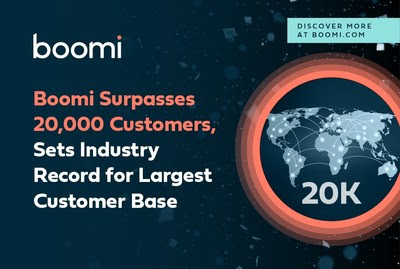- Boomi يتجاوز 20،000 عميل، مجموعات سجل الصناعة لأكبر قاعدة عملاء¹ شبكة Boomi العالمية من أكثر من 800 شريك، بما في ذلك Accenture, Capgemini, Deloitte, SAP, Snowflake, Amazon Web Services, Google Cloud, وMicrosoft، تساعد على تغذية نمو العملاء العالمي الرائد لشركة SaaS
- تستفيد العديد من شركات Fortune 500 والعلامات التجارية البارزة على مستوى العالم، مثل AT&T و Cisco و LinkedIn و Moderna و Novartis و Sky، من منصة Boomi AtomSphere™ لتحقيق نتائج أعمال أفضل
- مقاييس منصات Boomi ذات المستوى المؤسسي لدعم أكبر عمليات نشر العملاء، والتي تعالج مؤخرًا أكثر من تريليون مستند و 65 مليار تكامل مع نمو الطلب على الاتصال الذكي والأتمتة
تشيستربروك، بنسلفانيا، 9 يونيو 2022 /PRNewswire/ —
Boomi ™، رائد الاتصال والأتمتة الذكي، اليوم أنها تجاوزت 20,000 عميل، مما يمثل أكبر قاعدة عملاء لأي منصة تكامل سحابية كمزود خدمة (iPaaS). تستفيد 500 شركة وعلامات تجارية بارزة على مستوى العالم، مثلAT&T و Cisco و LinkedIn و Novartis، جنبًا إلى جنب مع الشركات الدولية الرائدة مثل Ampol والصليب الأحمر الأسترالي ووكالة حماية البيئة و Sky، من تحقيق نتائج أعمال أفضل.Moderna منصة™ Boomi AtomSphere يعتمد عملاء Boomi على البرامج العالمية الرائدة في الفئة كتكنولوجيا حائزة على جوائز من شركة (SaaS )، ومجتمع قوي، وشركاء عالميين لتسريع الإنتاجية، ودفع الابتكار، والازدهار أثناء التغيير.

بالإضافة إلى العمل مع العلامات التجارية في جميع أنحاء العالم، تعمل Boomi أيضًا مع المنظمات غير الربحية الرائدة التي تركز على ربط العالم إلى الأبد، وتوسيع مهمة Boomi لربط الجميع بكل شيء، في أي مكان. قال كريج أيزنبرغر، مدير خدمات منصة المؤسسات وإدارة البيانات في الجمعية الأمريكية لأبحاث السرطان: “يدعم فريقنا الأشخاص والأنظمة التي تجمع الباحثين معًا لتحقيق الهدف النهائي المتمثل في علاج السرطان “. “Boomi تمكننا من إنشاء اتصالات سلسة وفي الوقت الحقيقي بين أنظمتنا حتى نتمكن من الحصول على نسخة واحدة مشتركة من الحقيقة عبر منظمتنا. من خلال منصة Boomi، سننتج ونوزع بيانات أكثر دقة، وستمكن الرؤى التي نحصل عليها أصحاب المصلحة لدينا من قضاء وقت أقل في إنشاء التقارير والمزيد من الوقت في دفع مهمتنا إلى الأمام”.
قال كريس بورت، رئيس العمليات في Boomi: “تحتاج المنظمات العالمية اليوم إلى اتصال ذكي وأتمتة لم يسبق لها مثيل “. “تسبب انقطاع سلسلة الإمداد في خسارة في الإيرادات تقدر بمبلغ 4 تريليون دولار. إن إعادة التنظيم العظيمة والحاجة إلى دعم قوة عاملة هجينة ونائية متنامية يجهدان الموارد الهزيلة بالفعل. لا تزال الصوامع تمنع الشركات من إدراك قيمة بياناتها”. “الشركات من جميع الأحجام، عبر جميع المناطق الجغرافية والصناعات، تتجه إلى Boomi ونظامنا البيئي الواسع لحل تحديات مثل هذه بنجاح، بسرعة وسهولة.”

ساعدت شبكة Boomi العالمية التي تضم أكثر من 800 شريك، بما في ذلك Accenture و Capgemini و Deloitte و SAP و Snowflake، بالإضافة إلى أكبر ثلاثة مزودي خدمات سحابية — خدمات Amazon Web Services و Google Cloud و Microsoft — في تعزيز نمو العملاء السريع للشركة مع استمرار الطلب على الاتصال الذكي والأتمتة في التسارع.
تعمل منصة Boomi للتكامل منخفضة الكود، سحابية الأصل، على مستوى الشركات على دعم أكبر عمليات نشر العملاء – التي تعالج مؤخرًا أكثر من تريليون مستند و 65 مليار عملية تكامل – مما يمكّن الشركات من توحيد أنظمتها البيئية الرقمية الكاملة بسرعة وسهولة. من خلال توصيل البيانات والأنظمة عبر البيئات الرقمية الهجينة، يمكن للمؤسسات كسر صوامع الأعمال، وإطلاق العنان لقوة البيانات، وتبسيط سير العمل لخدمة العملاء والموظفين والشركاء بشكل أفضل.
تعمل منصة Boomi AtomSphere، باعتبارها الشركة الرائدة في مجال أنظمة iPaaS المستندة إلى السحابة، بمثابة العمود الفقري للابتكار في المؤسسات، مما يوفر آلاف الساعات في التطوير الممل ويسرع الوقت إلى القيمة مع معالجة متطلبات التحول الرقمي. يروج Boomi لمجتمع مستخدمين متنامٍ يضم أكثر من 100000 عضو وواحدة من أكبر صفائف تكامل الأنظمة العالمية (GSI) في فضاء iPaaS.
تحتل الشركة موقعًا رائدًا في فئة Gartner® Magic Quadrant™ لمنصة Enterprise كخدمة (EiPaS)2 لمدة ثماني سنوات متتالية، وقد حصلت مؤخرًا على جائزة Gold Globee ® في المنصة كخدمة (PaaS )، وحصلت على العديد من الجوائز لكونها صاحب عمل مفضل، بما في ذلك قائمة حديثة كواحدة من أفضل أماكن العمل في مجلة Inc.
الموارد الإضافية
- اقرأ المزيد عن كيفية نجاح عملائنا مع Boomi
- تعرف على المزيد حول منصة Boomi AtomSphere
- استكشف مجتمع بوم متنوعة
- تابع Boomi على Twitter و LinkedIn و Facebook و YouTube
إخلاء مسؤولية Gartner:
لا تصادق شركة غارتنر (Gartner) على أي بائع أو منتج أو خدمة مذكورة في منشوراتها البحثية، ولا تنصح مستخدمي التكنولوجيا باختيار البائعين الحاصلين على أعلى التقييمات أو أي تصنيفات أخرى. تتألف منشورات غارتنر البحثية من آراء شركة غارتنر البحثية، ويجب ألا تُفسّر على أنّها بيانات تعبّر عن حقائق ثابتة. تُخلي غارتنر مسؤوليتها عن جميع الضمانات، الصريحة أو الضمنية، فيما يتعلق بهذا البحث، بما في ذلك أيّ ضمانات متعلقة بالتسويق أو الملاءمة لغرض معين. GARTNER وMagic Quadrant هما علامتان تجاريتان مسجلتان وعلامة خدمة لشركة Gartner، Inc. و/أو الشركات التابعة لها في الولايات المتحدة وعلى الصعيد الدولي ويتم استخدامهما هنا بعد الحصول على إذن. جميع الحقوق محفوظة. ملاحظة: تم الاعتراف ب Boomi باسم Dell Boomi من عام 2014 إلى عام 2019.
نبذة عن Boomi
تربط Boomi الجميع على الفور بكل شيء، في أي مكان من خلال نظامها الأساسي السحابي الأصلي والموحد والمفتوح والذكي. يعتمد أكثر من 20000 عميل حول العالم على منصة تكامل Boomi كخدمة (iPaaS) لسرعتها وسهولة استخدامها وانخفاض التكلفة الإجمالية للملكية. بصفتنا الرائد في تعزيز الاستخدام الذكي للبيانات، تتمثل رؤية Boomi في جعل اكتشاف البيانات وإدارتها وتنسيقها سريعًا وسهلًا للعملاء والشركاء، مع ربط التطبيقات والعمليات والأشخاص للحصول على نتائج أفضل وأسرع. للمزيد من المعلومات قم بزيارة http://www.boomi.com.
© 2022 Boomi, LP. تعد Boomi وشعار “B” و Boomiverse و AtomSphere علامات تجارية لشركة Boomi أو LP أو الشركات التابعة لها أو الشركات التابعة لها. جميع الحقوق محفوظة. قد تكون الأسماء أو العلامات الأخرى علامات تجارية مملوكة لأصحابها.
للتواصل الإعلامي:
كريستين ووكر
العالمية للاتصالات المؤسسية
kristenwalker@boomi.com
+1-415-613-8320
1 أكبر قاعدة عملاء بين بائعي iPaaS
2 غارتنر، الربع السحري لمنصة تكامل المؤسسات كخدمة، إيريك ثو، كيث غوتريدج، بندي بولار، شامين بيلاي، أبيشيك سينغ، 29 سبتمبر 2021
الصورة – https://mma.prnewswire.com/
الشعار – https://mma.prnewswire.com/